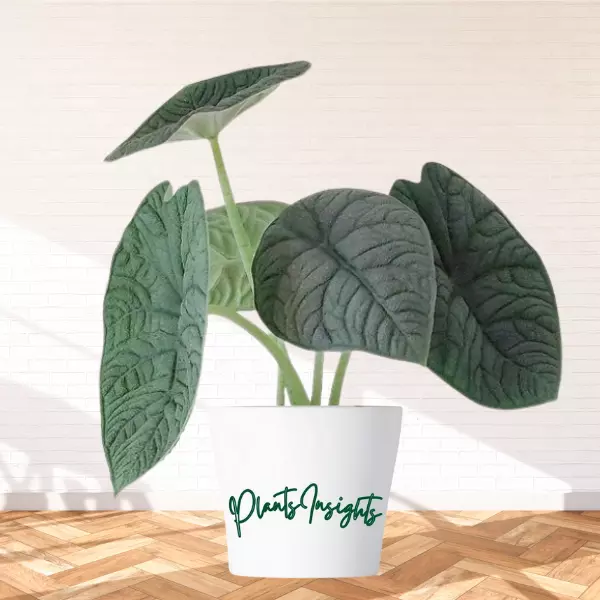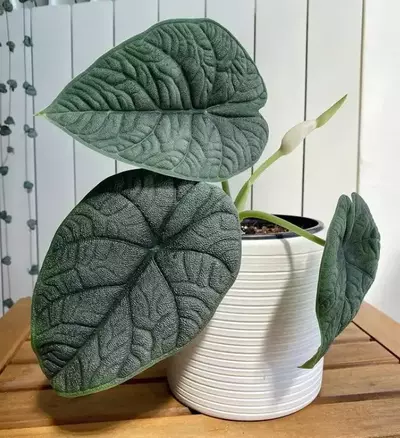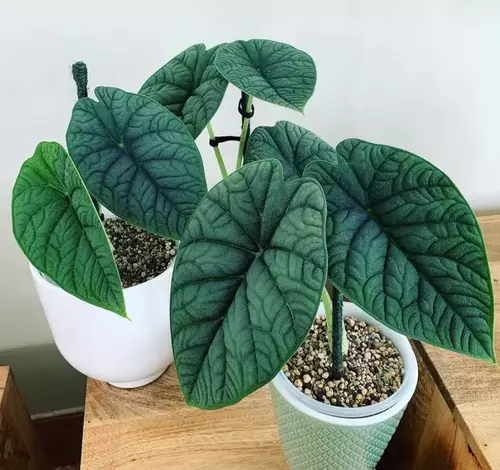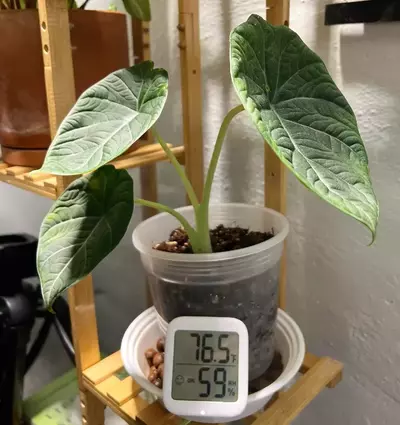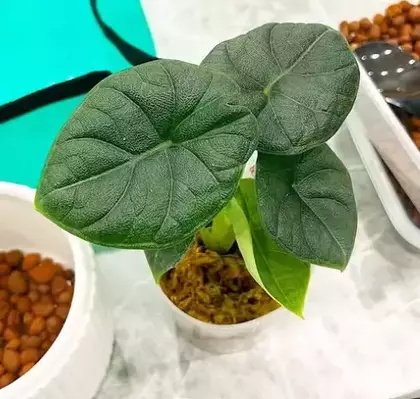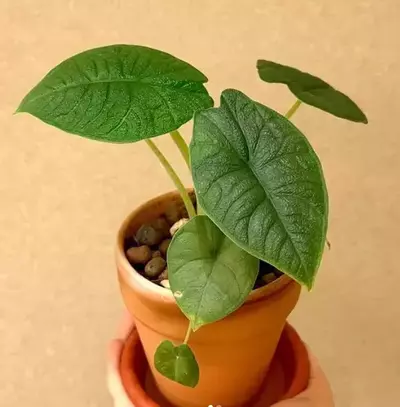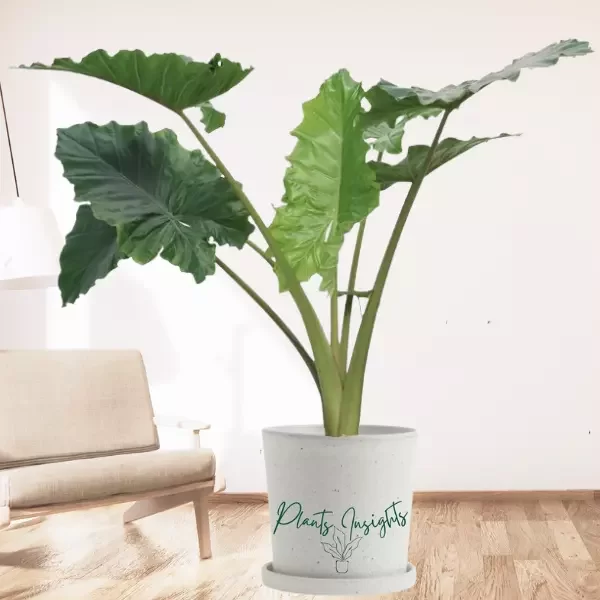In the Alocasia plant series, our today’s plant is a Jewel Alocasia the stunning Alocasia Melo. There are many exotic plants in the Alocasia genus, but Alocasia Melo differs from all because of its rugged textured leaves. The plant features jade or greenish-blue leaves that grow up to 20 inches in length and 10 inches in width. Compared to other Alocasias, it is considered a small plant as it can up to 23 inches in height.
It’s an eye-catching plant that will add attractiveness to your home. Besides its lush green textured leaves, it also grows flowers, but they are less than three at a time and don’t possess any fragrance. This species has the thickest leaves I’ve come across in any Alocasia species/variety. If you want to give a gorgeous guise to your home, this plant is for you.
Allied Species: Alocasia Sarian, Alocasia Pink Dragon, Alocasia Lauterbachiana, Alocasia Silver Dragon, Alocasia Stingray, Alocasia Regal Shields, Alocasia Nebula, Alocasia Maharani, Alocasia Jacklyn , Alocasia Cuprea, Alocasia Cucullata, Alocasia Cuprea
Related Products
Products | Name | Check Price |
Organic Perlite for Plants | ||
WONDER SOIL Organic | ||
Orchid Potting Bark Mulch |
Habitat & Ecology
Alocasia Melo is native to Southeast Asian Forest regions, specifically Indonesia. It grows in the shade of higher shrubbery and nurtures in rocky terrains, unlike its other family members. This plant is known scientifically as Alocasia Rugosa because of plant’s thick, rugose/corrugated & bullate/blistered-textured leaves, which feel like foam rubber & Naugahyde “leather.”. At first glance, anyone can mistake this plant for an artificial one.
You may also find sellers referring to them as “Melo Badak” or “Rhino skin Alocasia”; these are also common names for this beauty. “Badak” is the Malay word for “rhinoceros,” & rhino skin is the perfect description for the color/texture/thickness of the leaves on these plants.
| Botanical Name: | Alocasia Rugosa |
| Family Name: | Araceae |
| Common names: | Alocasia Melo |
| Origin | Southeast Asia (Indonesia) |
| Humidity: | 75%-95%. |
| Temperature: | 68°F– 86°F |
| Light Need | Bright Indirect light |
| Soil | Well-draining, airy soil |
| Water | Water your plant when top 2 inches of soil is dry |
| Pests | Mealybugs, Aphids |
| Diseases | Root rot, Powdery Mildew |
How do you take care of Alocasia Melo?
Alocasia Melo is a stunning plant that is sought after all around the world because of its unique greenish-blue-coloured leaves that have incredibly carved channels in them. It is one of the trickiest Alocasias when it comes to care ,definitely not a “beginner” species of Alocasia.
If you have grown-up Alocasias before, you won’t face complications while mounting the Melo. For all those new to this plant and who didn’t have Alocasias before, keep reading this care guide on Alocasia Melo. The guidelines shared in this guide will help you to grow it successfully.

Initial Care at Home
Although Alocasia Melo needs intermediate care, appropriate care is essential to growing it successfully. It’s a tropical plant that doesn’t bear bright direct sunlight. Therefore, ensure you keep it in a place with no direct light. Also, you must be very careful with this plant, especially if you have children and pets, as it’s very toxic.

Watering
Alocasia Melo doesn’t tolerate excessive water; therefore, avoid overwatering at any cost . The plant is happy when it’s given a moderate amount of water. It’s always a good deal to keep the plant under shade. If you keep the plant outdoors, keep a constant check on the weather, and in case of rain, immediately move it under shade as it’s highly intolerant to water and can’t endure wet soil for even a few hours. The plant may suffer a leaf loss within hours in case of overwatering.
Avoiding overwatering doesn’t mean you don’t water the plant. Watering is recommended when you notice that the upper two inches of soil are dry. Also, in colder conditions, the water frequency decreases.

How much Sun does a Alocasia Melo need?
Although Alocasia Melo has thick rubbery leaves, it doesn’t mean it can withstand bright direct sunlight like cacti and succulents. As opposed to succulents, the leaves of Melo are susceptible to sunlight and will burn if kept in direct light. The plant is happy in partial shade and receives bright indirect sunlight. This plant nurtures fast when it obtains the required sunlight.
However, avoid keeping the plant in dark spaces because it doesn’t take an adequate amount of light, the leaf growth will stop, and they will lose their attractive jade colour. Consequently, if you place this plant indoors, choose a place with sufficient light. We recommend rotating the plant to guarantee its even progress and growth.

Humidity and Temperature
Like all other Alocasias, Melo also loves humidity, and when there is deficient moisture in the air, the plant’s leaves will lose their colour and freshness. The ideal humidity level for this Alocasia is 75% during the day and 95% at night. The plant requires a high humidity level compared to normal household humidity. To deliver its vital humidity level, you should try some tricks, such as placing a humidifier near it to keep it happy and healthy.
As for as the temperature is concerned, the plant loves a warm environment. The ideal temperature is between 68 Fahrenheit to 86 Fahrenheit. It will flourish as long as the room environment is suitable for Melo; therefore, you should make some arrangements to provide the required temperature.
For example, when the room gets colder, try keeping a heater in the room, and on a hot day, try misting the plant leaves. Misting will increase the evaporation rate, and eventually, the temperature around the plant will drop.

Soil Requirements:
A suitable soil for Melo Alocasia is well drained and well-aerated. The best soil for this plant is that it doesn’t get saturated with water. You cannot use regular potting soil for Melo as it retains too much water, becomes dense with time, and can cause many problems to the plant.
Hence, the soil you use for Alocasia Melo should be well drained and aerated. You can make your potting mix for this plant to ensure its healthy growth.
A potting mix that will be advantageous for Alocasia Melo contains the following.
To make a mix, mix all ingredients in a bowl.

Repotting:
Well-drained soil is recommended for Alocasia Melo as it is aerated. Unexpectedly, the roots of the Melo like to be root bound, and that’s why it doesn’t need an enormous container. Thus, it doesn’t want to be repotted very often.
You don’t need to repot the plant unless you see that the rhizome has expanded from the pot. Another indication of repotting is the roots coming out of drainage holes. If you notice that the roots have outgrown the drainage holes, it’s time to repot the plant.
Make sure you use the right potting mix containing all the necessary nutrients. For good drainage, add small stones at the bottom of the pot.

Propagation of Alocasia Cuprea:
Rhizomes are underground stems of Alocasia Rugosa, and these stems are responsible for the plant’s growth. Usually, the Melo’s propagation is executed through rhizomes, and that too at the time of repotting. It’s a win-win situation because you can achieve two drives from a single activity.
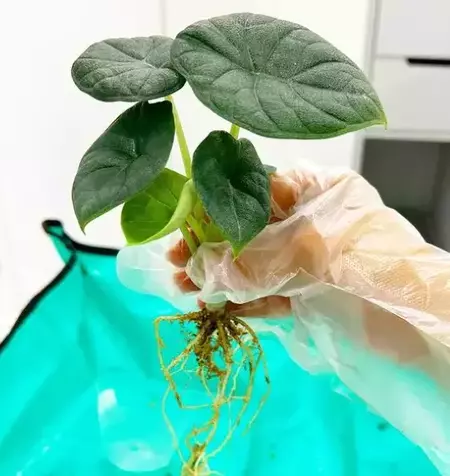
The propagation is done through rhizome division at the time of repotting. Let us explain the entire process of how you can propagate the Rugosa plant.
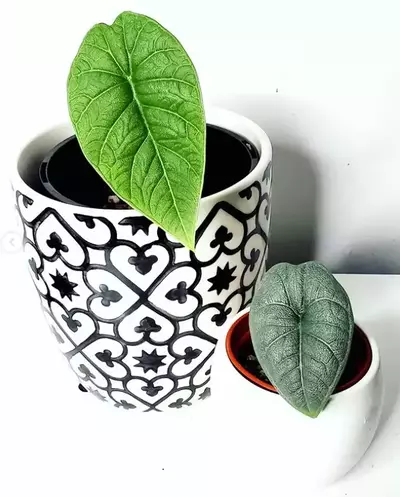

Fertilizer
Alocasia Rugosa is not a heavy feeder but needs fertilizer in its growing season. The active growth seasons of this plant are summer and spring. You can opt for balanced houseplant fertilizer or foliage plant feed, but ensure you don’t over-fertilize. It can cause mineral accumulation in the soil, which is harmful to the plant.
In case of over-fertilizing, flush the soil with water to wash away minerals. You can also repot the plant to avoid any damage. Before giving the fertilizer decrease its strength by half to prevent fertilizer burn in the plant.

Maintenance:
Like any other household plant, Alocasia Melo also needs maintenance. It is recommended to prune this plant yearly to maintain its shape and appearance. Additionally, remove old leaves from the plant at the beginning of each season. Trimming old leaves will boost plant growth and health.
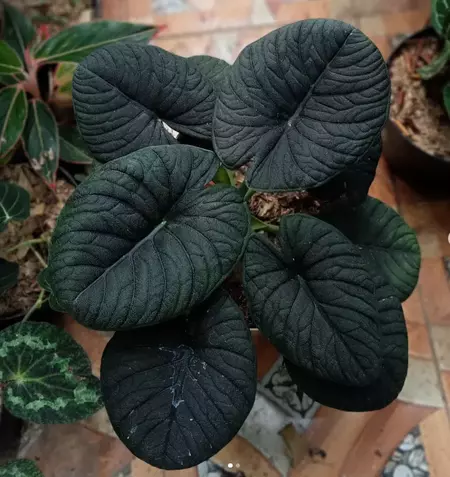
You can use a pair of sharp scissors for pruning but remember to disinfect and sterilize the scissors before use.

Toxicity
The Alocasia Rugosa is a highly toxic plant whether it touches the skin or is consumed. It produces allergies and rashes on the skin. Therefore, keeping the plant away from children and pets is essential. Immediately take the pets and humans to the hospital if it is accidentally eaten. Also, don’t forget to wear gloves at the time of pruning.

Common Problems and Pests
The most communal problems related to Alocasia Melo are fungal attacks and pests. Furthermore, unfavorable climatic conditions like temperature, humidity, and direct sunlight will devastate the plant’s foliage.
The usual pests that attack Alocasia Melo are mealybugs and aphids. Keep reading below to know how to tackle these issues.
Aphids
They are the most common pest that attacks the plant primarily. They weaken the plant by feeding on its saps. You can identify the aphid’s attack by yellow spots on the leaves, or the leaves will get brown. If not treated on time, the plant will suffer from stunted growth, and it can die.
Mealybugs
Mealybugs are another common pest that can be seen on Alocasia Melo resembling small cotton candy balls. You can easily spot them under the plant leaves. They cause the yellowing of leaves and secrete a tacky fluid on the leaves’ surface known as honeydew. The presence of honeydew on the foliage invites fungal spores which could eventually result in the formation of mold.
How to treat the Pests?
Sunburn
Your plant will have sunburn if it’s directly placed in the sunlight. Furthermore, the sunburn will be more severe if you keep the plant in the afternoon light.
When Alocasia Melo sunburns, its leaves lose their jade colour and turn brown. The wrinkles also appear on them. To avoid this problem, never place your plant in direct light.
Diseases
Following are the most typical diseases the Alocasia Melo may come across during its life span.
Root Rot
Poor drainage or overwatering is the main grounds of root rot. When you notice irregular rot spots on the leaves and other parts of the plant, your plant is affected by this disease. You will observe the excessive falling of the leaves eventually leading to the plant’s death.
You can treat root rot by removing the plant from the pot and eradicating its affected roots and other parts. Repot the plant in a new container with sterilized soil. Also, regularly apply a fungicide for the next two weeks to prevent the recurrence of the disease.
Powdery Mildew
It is a fungal disease that can distress your Alocasia Melo. It’s not that fatal, but it affects the beauty of the plant making it unattractive. In the beginning, white specks will be visible on the foliage, and with time they will get enlarged and combine to form large clusters, which will look like the leaves are brushed with white powder.
· Regular application of neem oil will treat the problem as neem oil works as a fungicide.
· You may use a diluted solution of vinegar and water on the affected areas of the plant.
FAQs
Does Alocasia Melo need a lot of sunlight?
Alocasia Melo needs bright but indirect sunlight because of its natural habitat. Direct light will cause many problems in the pant, such as sunburn. Therefore, always place your plant in an indirect light spot. It’s better to keep the plant in the shade.
How do you know that your Alocasia plant is overwatered?
Overwatering may cause root rot and fungal infections in the plant. If the leaves turn yellow or brown, the soil is saturated with water.
Should I mist my Alocasia plant?
Alocasias like a humid environment; if you feel the humidity levels are low for the plant, mist it often. You can also mist your plant on a hot day to prevent it from drying.
Final Words
Alocasia Melo is a beautiful plant with large textured leaves and lush foliage. The colour of leaves in young plants is jade; when they mature, they turn slate blue.
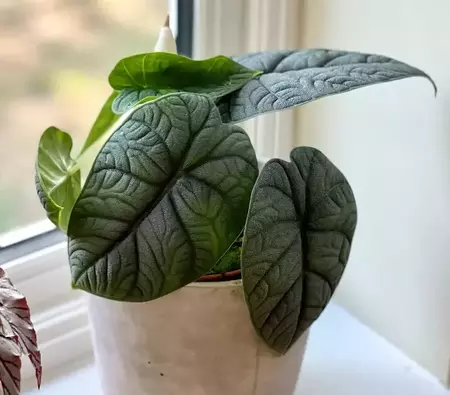
This plant is happiest and grows fast when kept in indirect sunlight and provided the aerated and well-drained soil. It will also flourish in a bit warm environment with high humidity.
Unlike other Alocasias, Melo is a short plant that is well suited for indoors as it increases the appeal of your home. Also, it’s a low-maintenance plant, but it needs care and attention like all other plants. Give it love and see its wonders in your home.
What are you waiting for? Get this exquisiteness home soon.
Related Posts
Alocasia Calidora | Elephant Ear (Persian Palm) Care
Araceae Family has many gorgeous, attractive-looking, and ornamental indoor plants; Alocasia Calidora is one of them. Alocasia Calidora is a cultivar featuring large ruffled-edged attractive, lush green leaves. Owing to large foliage got the name ‘Calidora’ Elephant ear. These large…
Ctenanthe Setosa ‘Grey Star’ Care and Propagation Guide
Are you a plant parent who struggles with Calatheas and wants an ornamental plant that is forgiving and exhibits the same striking beauty as stunning Calatheas? Look no further! Ctenanthe (pronounced te-NANTH-ee) Setosa ‘Grey Star’ of the Marantaceae family is…
Alocasia Portodora (Upright Elephant Ear) Care Guide
Alocasia Portodora or Portora is an adorable plant with its lush, glossy green tropical leaves, and inviting look. Its alternate name, Upright Elephant Ear plant, refers to its upward-pointing scalloped leaves on thick green stems. Southeast Asian tropical rainforests are…
Ctenanthe Oppenheimiana | Giant Bamburanta Care Guide
Ctenanthe Oppenheimiana (Never Never Plant) is a bushy perennial plant found mainly in tropical forests in Northeast Brazil. It also goes by the trade name Ctenanthe’ Compactstar’. This herbaceous plant with variegated leaves belongs to Marantaceae (Prayer plant family). It is…
Alocasia Black Velvet | Alocasia Reginula Care & Propagation Tips
Alocasia family has so many exotic plants, but Alocasia Black Velvet stands out among all because of its stylish appearance ,texture and compact growth habits. It exhibits contrasting silver veins which are prominent over dark leaves with a velvety background. This…


